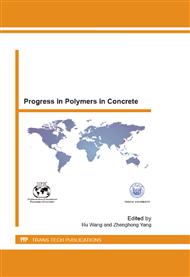p.94
p.100
p.107
p.112
p.118
p.124
p.130
p.136
p.144
Hard and Soft: Principles of Polyner-Impregnated Concrete Using Elastomers
Abstract:
The effect of incorporating elastomeric domains in concrete is described from the point of fracture mechanics. Concrete is subject to brittle failure, since cracks propagate at an enormous speed in the crystalline matrix. However, micro cracks are attracted to volume elements with lower elastic moduli such as elastomeric domains. Cracks that encounter the concrete-elastomer interface are stopped since energy is dissipated by plastic deformation of and/or crack deflection by the elastomer. The domain size and the distribution of the elastomer as well as, and properties of the elastomer-concrete interface are crucial parameters. Such a combination differs substantially from previously prepared polymer-impregnated concretes, in which only glassy polymers were used.
Info:
Periodical:
Pages:
118-123
Citation:
Online since:
April 2013
Authors:
Keywords:
Price:
Сopyright:
© 2013 Trans Tech Publications Ltd. All Rights Reserved
Share:
Citation:


